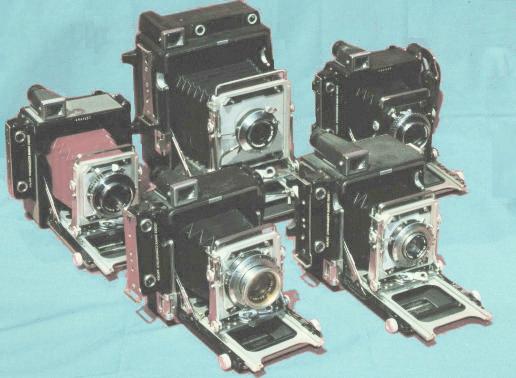

The rangefinder on one of the Centuries was far off, and I pulled out my Xerographic photocopy of instructions on how to adust the Kalart rangefinder. After an hour or so, it is now ``on the money'' at all distances except 4 feet, which is a foot off. Actually the instructions were fairly simple to follow, and the result worthwhile.
I have never had a Graphic rangefinder that didn't require some ``tweaking.'' Setting the camera up on a tripod and focusing on a tree several blocks away (using a focusing aid such as a projector lens) will usually disclose that the infinity stops are not properly set to infinity. This is critical for sharpness. Then, the Kalart rangefinder can be set so the double images are "coincident" (overlap to appear as one image) by adjusting the cam near the back of the bedrails. The cam can be turned using a screwdriver that has had the tip "rounded". Perhaps a dime can be used. By turning the cam, the rangefinder can usually be adjusted to infinity. Next, the bed scale must be adjusted so that infinity on the bed scale agrees with the infinity stops. Next, the camera should be put on a tripod and the camera set at 6 feet, 10 feet and 15 feet from a target taped to a wall. If you're reasonably lucky, the rangefinder will be within a foot or so at all distances. Closer is better. If much farther off, it should be adjusted. This can be done by the novice if he/she follows the instructions in the brochure Using and adjusting the Kalart Rangefinder. Or the camera can be sent to a pro. But unless the user wants to rely on the groundglass for sharp prints, the rangefinder must be adjusted before it is used--if it is out of adjustment.
The biggest limitation of the 23 Graphics is that the lensboard is too small to use some of the modern, faster (bigger diameter) lenses. (The original lenses were around f4.5.) A 100mm f3.5 coated Zeiss Tessar in Synchro Compur shutter from a Graflex XL can be used (without the body release of the Pacemaker) if it is turned ``just so.'' Otherwise, the bed won't close properly. Or it will close, but the cocking lever will be bent. A 2.8 Zeiss Planar (wild!) from the XL can be used, but the rear cell first must be removed, the back removed, and the rear cell screwed back on from inside the bellows...but forget about closing the bed! When the 100mm Zeiss Planar was last offered in New York discount houses in the mid 70's, the price was around $600. What might it be priced at today?
One good modern lens for the 23 Graphic is the 100mm f5.6 Schneider Symmar or Rodenstock Sironar. A 105mm f5.6 Nikkor would probably be a good choice also. They are sharp and offer a larger image circle for use of the rising front. And the lens is small enough in diameter to allow the bed to close. As I recall, the Symmar can be used with the body release of the Pacemaker Crown and Speed. The Century, of course, has no body release. Not a ``biggy'' however, because most people can't use the body release without jarring the camera when releasing the shutter, so use a shutter release cable.
One lens I would like to own someday is a 100mm Schneider Componon in a modern shutter. These occasionally turn up at shows and turn the lowly graphic into a fine camera for copying old photos.
One of the contributers implied that the Wollensak lenses were passed over for the Schneider Xenar lenses because the Schneider lenses were cheaper. This is possible, but I suspect that this changeover occurred about the time Wollensak stopped producing lenses. One friend said he had a 135mm Xenar that was terrible. However, because of the years of use on these lenses, it may have been that some amateur ``repairman'' had repaired it, one never knows. Schneider has an excellent reputation. Some of the late Optars were labled as manufactured by Rodenstock. If any of the Optars were generally of better quality, it was probably these Rodenstock Optars. However, I don't have tests to support this suspicion.
Another limitation for Graphics prior to the Pacemaker Crown or Speed Graphic Special (top rangefinder model) is that interchangeable cams were not available. Cams were not available for side rangefinder models, but they were available for top rangefinder ``special'' models. [Cams are also available for the Super Graphic, but they are not the same as the Pacemaker Special cams. -- ed]. Cams for most focal lengths can probably be ``scrounged'' at camera swaps or by calling dealers specializing in Graphic parts and accessories, listed here or in Shutterbug or The Camera Shopper.
Although I have a 4x5 Crown Graphic Special, my preference is the 23 Graphics with Graflok back. They are lightweight and compact for back packing, and with Graphic or Mamiya rollfilm adapter, offer medium format results on a beer budget. And they are a lot of fun to use. With today's improved films, they perform better than when they were new. With an upgraded lens, they should turn out enviable results with economical 120 or 220 rollfilm.
R. Peters |
| Brought to you by Graflex.Org
Questions or comments? |